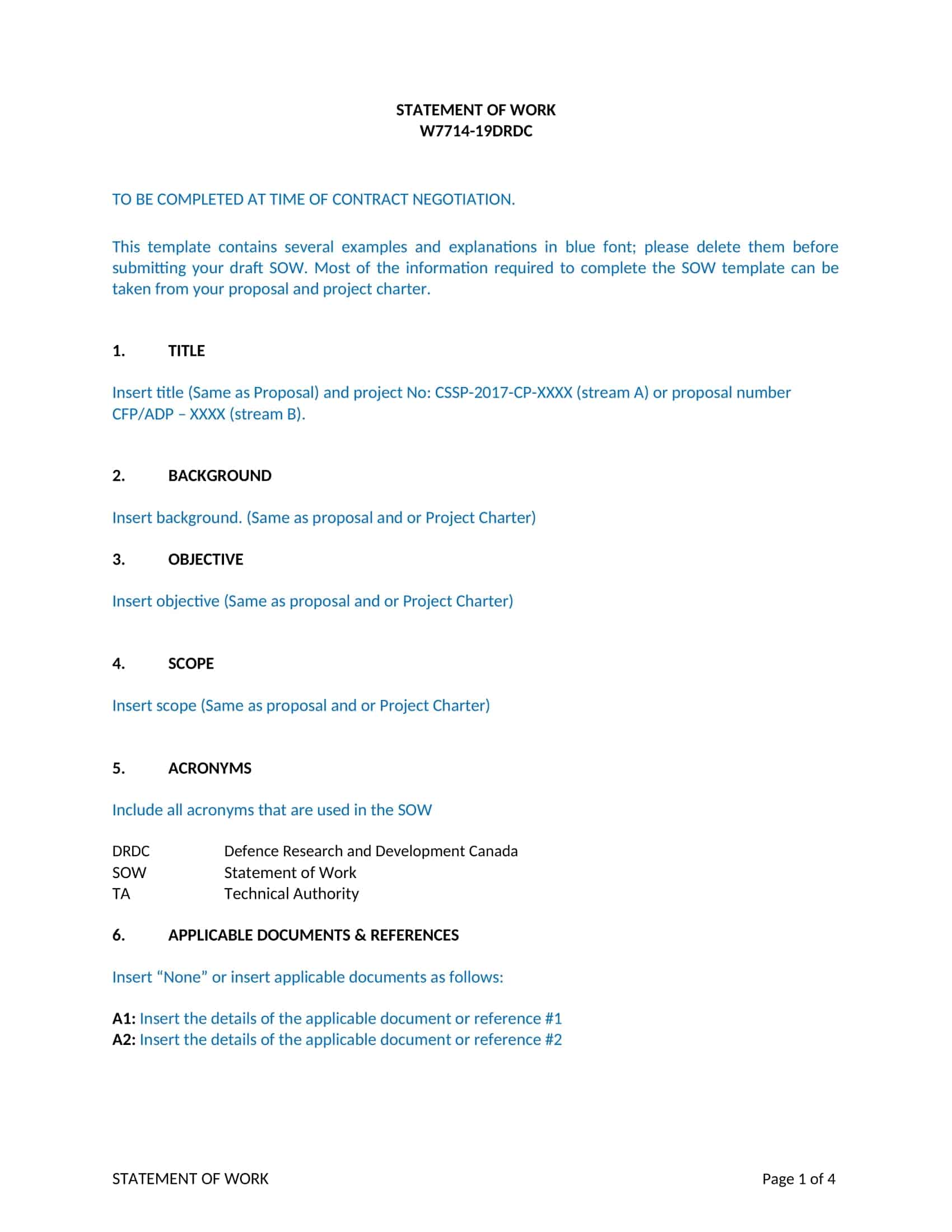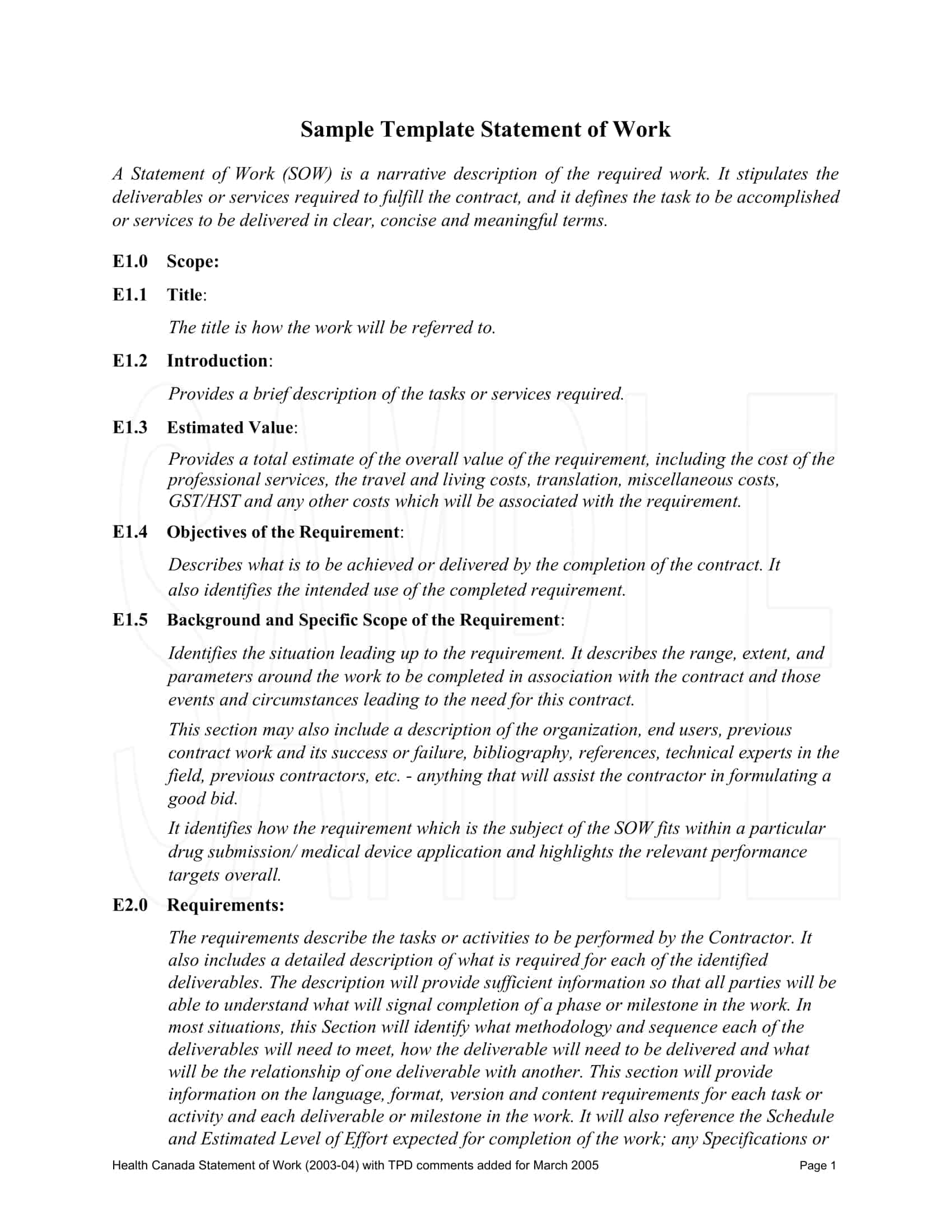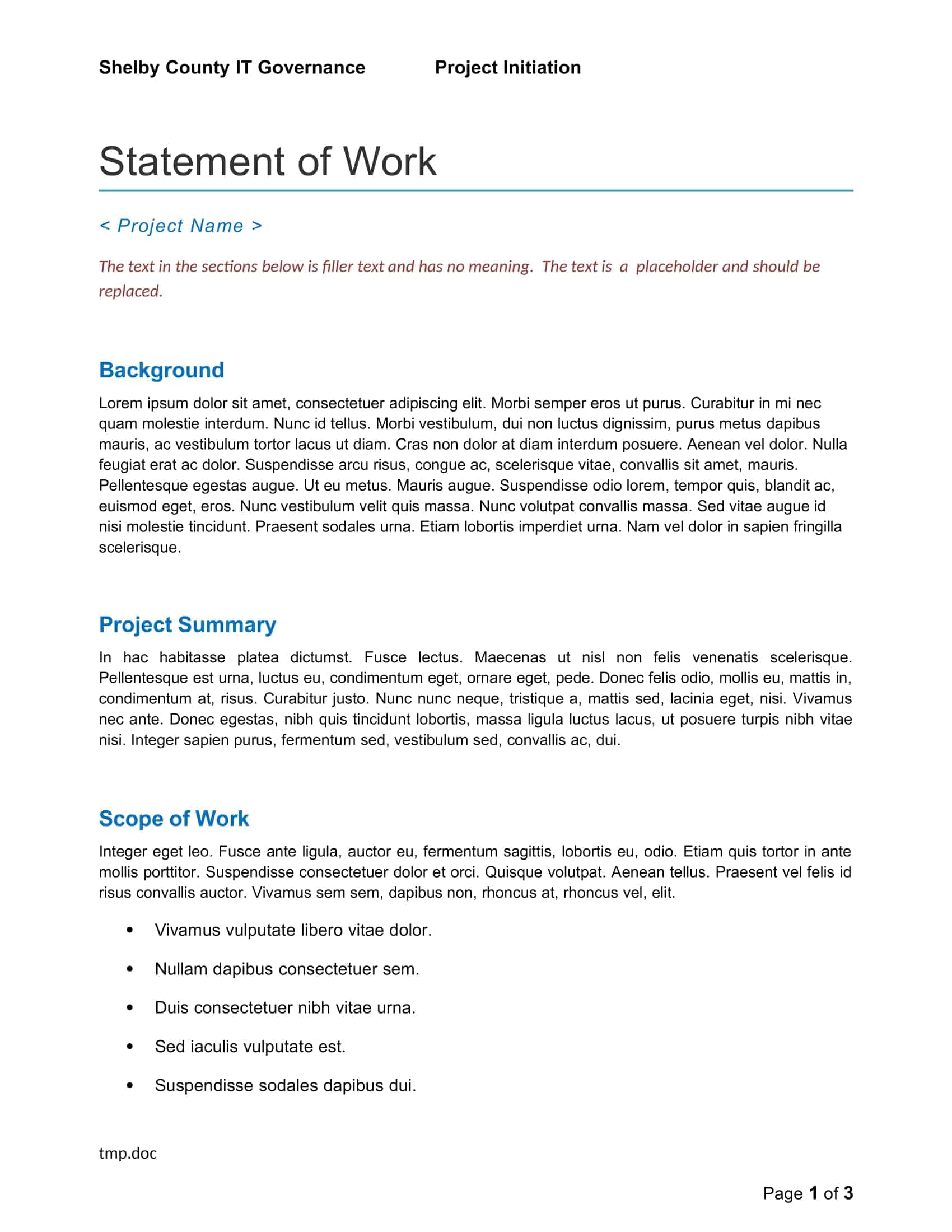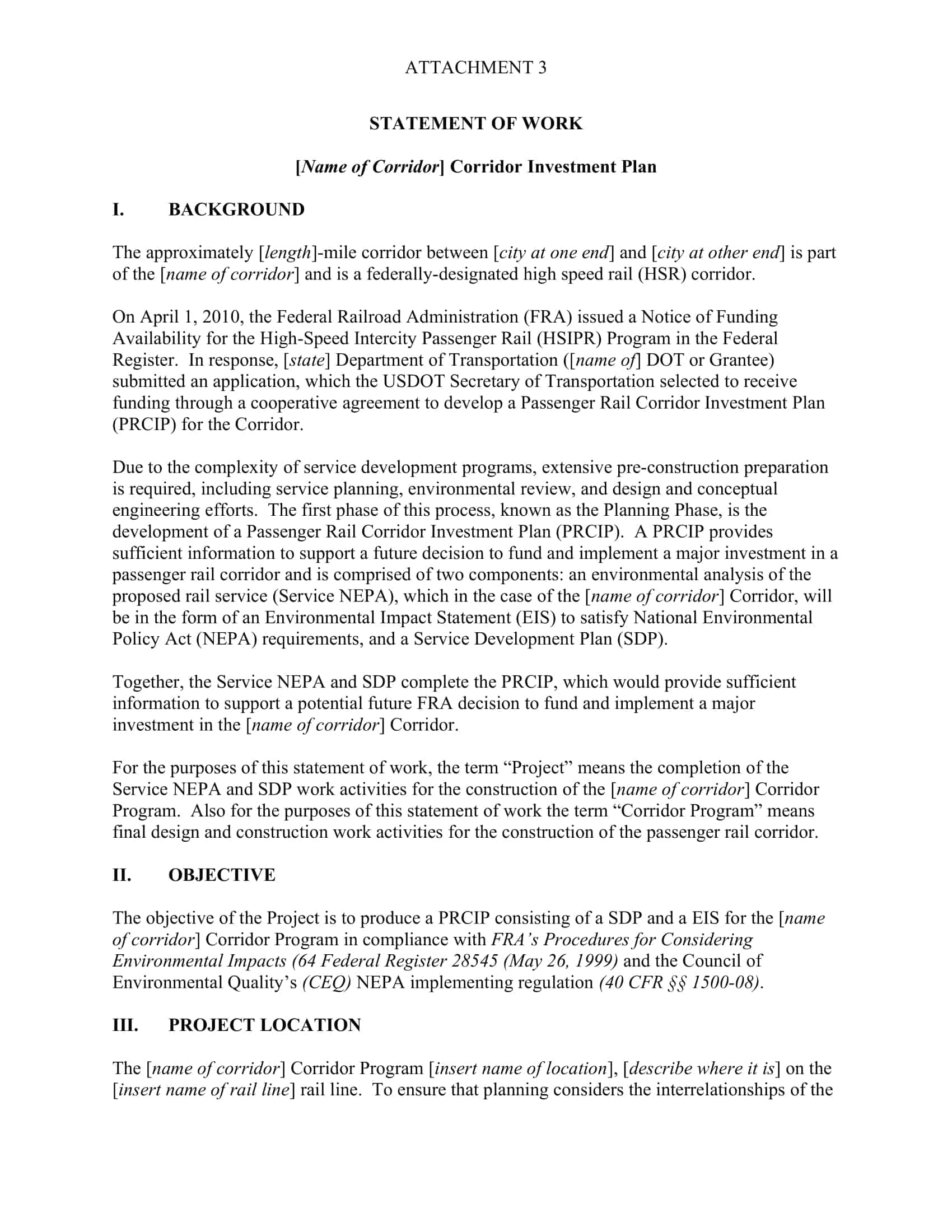On this page, you’ll find a sample statement of work template which can be used in your next project. We’ll talk about its main sections and explain why they’re important, what should be included in each of them and how to fill them out correctly.
Table of Contents
What Is a Statement of Work?

A template widely used in projects aimed at the service industry and companies dealing with custom software development, an SoW (Statement of Work) is a contract that specifies the project deliverables for both parties – i.e., the agency and the client.
The process of writing a statement of work requires clarifying certain terms, such as project objectives and success criteria, among other areas, to establish a common understanding between all involved parties over what needs to be achieved concerning the project completion.
Statement of Work Templates
Effectively define project scopes and deliverables with our comprehensive collection of Statement of Work Templates. These customizable and printable templates provide a structured framework for outlining the specific tasks, objectives, and requirements of a project. Our templates cover essential sections such as project description, deliverables, timeline, resources, and milestones.
By utilizing our Statement of Work Templates, you can establish clear expectations, minimize misunderstandings, and ensure alignment between project stakeholders. Whether you’re a contractor, freelancer, or project manager, our templates offer a valuable tool to communicate project details, scope, and responsibilities. Streamline your project management efforts, enhance client satisfaction, and drive successful project outcomes with our user-friendly templates. Download now and create comprehensive statements of work that set the stage for successful project execution.
Statement of work template types
While some schools of thought suggest that a Statement of Work (SOW) should be created for every job you undertake, not all SOW templates apply to every industry. To help you determine which category best fits your needs, we’re covering three of the most common types of SOW templates below:
Design or Detail SoW
These types of SOWs typically include a description of what is to be done, how it is to be done, and the resources required to do so. They usually also include a timeline for when each step will take place and how long each step should take. This type of template is useful if you want to ensure that you get exactly what your vendor wants (and that they don’t go off-track).
Level of Effort or Time and Materials or Unit Rate SoW
These kinds of SOWs have less detail than detailed ones. They typically describe what needs to be done in terms of units or time rather than with specific steps. For example, the unit rate might be $x per hour, while the time could be 15 hours per week for three months. The advantage here is that it allows for flexibility about timelines (as long as both parties agree) because things can change without having to renegotiate anything.
Performance-Based SoW
Performance-based SOWs are designed to give both parties more flexibility when negotiating terms and conditions. This type of contract allows each party to independently negotiate different aspects of a project, such as a scope and a price, instead of having everything set in stone before any work begins.
What should a statement of work include?
Common elements of an SOW include:
Introduction
The introduction should clearly state the purpose of this statement of work template. This is where you state why you need this document and what it will accomplish once completed. Also, it gives a brief overview of the project that has been given to you to create this particular statement of work template.
Background
The background section explains why you are creating this document as well as how much time and effort was spent on creating it. This section explains who will use this particular statement of work template and how it will be used after its completion.
Purpose
Does this section explain what exactly your statement of work template will do for your client once completed? It also explains how important this document is for the success or failure of their project.
Location
The location where you want the project to be carried out should be stated in this segment. If the project is for a business office, then the location would be stated as such and not as a residence or other building, which might confuse the contractor and cause him to assume that he needs to go elsewhere.
Schedule
This section states when you need the project to be completed so that there is no conflict between your timetable and theirs. If there are any deadlines involved, these would also be stated here so that there are no misunderstandings between both parties on when they must meet with each other again.
Deliverables
This part describes what exactly has to be done by the contractor for him/her to receive payment from you (if applicable).
Milestones
The milestones in your statement of work should be specific and measurable. For example, if you are building an app, you can state the number of features you will build and when they will be implemented.
Tasks
A task is a set of activities that are required to accomplish a goal. They form part of the milestones mentioned above and must be measurable as well.
Plan for communication and reporting
It is important to state how often you will communicate with your client and how you will communicate with them. You might want to mention what channels will be used for this purpose so that there is no confusion later on when something goes wrong, or someone needs clarification about something else related to the project at hand.
Define success
A statement of work should include standards, testing, and other quality assurance measures that will be applied during development. This is important so that both parties know what to expect from each other. The details must also include measuring whether or not the project has been successful.
For example, if the project aims to improve customer satisfaction by providing better quality products and services, then metrics must be used to measure customer satisfaction after implementation. If there are no such metrics, how would we know if our goal has been achieved?
Requirements
Requirements are at the core of every software development project because it helps stakeholders get a clear picture of what they want from the developed product or service. Requirements can range from functional requirements that detail what must be done and why to non-functional requirements that detail other things such as performance, security, and usability.
Standards and testing requirements
The standardization and testing requirements are critical components of any statement of work. This section describes the testing procedures, standards, tools, and resources used during the project’s development and maintenance phases.
Payment
The payment section is where you list out all the services and items that need to be provided by your contractor. Also, you will find out how much money you need to pay for each service or item. This helps you keep track of your expenses and also helps you determine if the contractor is charging an appropriate amount or not.
Closure
The closure section is where you specify when exactly the contractor will deliver what they have promised. You also need to include a clause that says if they fail to do so within this time frame, then they will have to pay a penalty fee which will be determined by both parties beforehand.
Other
This section includes any other information that both parties might feel necessary, such as warranties, licensing agreements, etc…
How do you write a work statement?
A statement of work (SoW) is a written contract between two or more parties that describes exactly what needs to be done to complete a project. What separates the SoW from an informal letter of intent is that the former is more comprehensive and descriptive, specifying the “who,” “what,” “why,” “when,” “how much,” and even “how long.”
We have compiled below what you need to know to write an effective work statement:
Start by writing your objectives.
An objective is what you want to accomplish with your project or why you need it. It should be specific enough that you can clearly define what success looks like for your project. For example, if your objective is to increase sales by 20% in the next quarter, you’ll know what success looks like when you hit that goal.
Create an outline of the scope along with deliverables and assumptions
Next, create a list of deliverables — what exactly should be delivered? For example, if it’s a website redesign project, then this would include pages, graphics, and other assets needed for launch. List any assumptions made during development as well; these may not be known at this point but will likely affect how work progresses (e.g., database structure).
Come up with a schedule.
This can be as general or specific as you want — just ensure everyone agrees on what needs to happen and when. Give those dates here if you know exactly how long things will take from start to finish. If you don’t yet know them all off hand but want to be flexible about some aspects (for example, if you’re dealing with external suppliers), simply indicate that parts are subject to change depending on their availability or capacity. You can also include deadlines for major milestones.
List the key assumptions.
Include any dependencies or constraints such as timeframes, availability of resources, and additional information required from the client. These dependencies will help you determine how long it will take for your team to complete their task based on how quickly they can access this information from their client.
Establish the price
One of the important steps in creating an SoW is determining how much you want to charge for your work. There are many ways to do this, but one of the easiest is with a cost-plus pricing model. This involves starting with what it costs for you to produce your product or service, then adding an additional margin based on industry standards or averages for similar projects.
Acceptance criteria
When you write an SoW, you want to ensure that you clearly define what you need from your supplier/vendor. You want them to understand how they will be evaluated at each delivery stage. You also want them to know exactly how they can earn their money — this is where acceptance criteria come in handy!
What is the difference between MSA and SoW?
MSA: It is a document that contains all essential details of the contract, including scope, deliverables, payment terms, etc. This document can be used to generate multiple types of contracts, such as service level agreements (SLAs), project management plans (PMP), etc., while keeping the same framework.
SoW: On the other hand, it gives more specific details about one project or task at hand. The SoW will provide more information about what needs to be done by whom, when, and how much it will cost.
In short, MSA is an agreement, while SoW is a detailed document explaining what needs to be done and why it needs to be done.
FAQs
What is a statement of work template?
A statement of work template is a pre-made document outline containing standard SOW sections, tables, and placeholder content. It provides a consistent structure for developing new SOWs more efficiently.
How do I write a statement of work?
To write a statement of work:
- Establish the goal and objectives
- Outline the scope of services/work required
- Specify deliverables, timelines, milestones
- Define roles and responsibilities
- Include pricing and billing information
- Add acceptance criteria and KPIs
- List other contractual terms if needed
How do I create a statement of work template?
To create a statement of work template:
- Make headings for background, goal, scope, timeline, pricing
- Add tables for deliverables, milestones, responsibilities
- Include placeholder texts as examples
- Format professionally with your logo
- Save as a reusable template file
What should a statement of work include?
A statement of work should include:
- Background
- Goals/objectives
- Project scope and specifications
- Timeline, milestones, delivery schedule
- Roles and responsibilities
- Pricing/billing schedule
- Acceptance criteria and KPIs
- Legal terms as needed












































![Free Printable Food Diary Templates [Word, Excel, PDF] 1 Food Diary](https://www.typecalendar.com/wp-content/uploads/2023/05/Food-Diary-1-150x150.jpg 150w, https://www.typecalendar.com/wp-content/uploads/2023/05/Food-Diary-1-1200x1200.jpg 1200w)
![Free Printable Credit Card Authorization Form Templates [PDF, Word, Excel] 2 Credit Card Authorization Form](https://www.typecalendar.com/wp-content/uploads/2023/06/Credit-Card-Authorization-Form-150x150.jpg)
![Free Printable Stock Ledger Templates [Excel,PDF, Word] 3 Stock Ledger](https://www.typecalendar.com/wp-content/uploads/2023/08/Stock-Ledger-150x150.jpg)
